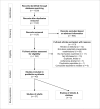Determinants of preventable readmissions in the United States: a systematic review
- PMID: 21083908
- PMCID: PMC2996340
- DOI: 10.1186/1748-5908-5-88
Determinants of preventable readmissions in the United States: a systematic review
Abstract
Background: Hospital readmissions are a leading topic of healthcare policy and practice reform because they are common, costly, and potentially avoidable events. Hospitals face the prospect of reduced or eliminated reimbursement for an increasing number of preventable readmissions under nationwide cost savings and quality improvement efforts. To meet the current changes and future expectations, organizations are looking for potential strategies to reduce readmissions. We undertook a systematic review of the literature to determine what factors are associated with preventable readmissions.
Methods: We conducted a review of the English language medicine, health, and health services research literature (2000 to 2009) for research studies dealing with unplanned, avoidable, preventable, or early readmissions. Each of these modifying terms was included in keyword searches of readmissions or rehospitalizations in Medline, ISI, CINAHL, The Cochrane Library, ProQuest Health Management, and PAIS International. Results were limited to US adult populations.
Results: The review included 37 studies with significant variation in index conditions, readmitting conditions, timeframe, and terminology. Studies of cardiovascular-related readmissions were most common, followed by all cause readmissions, other surgical procedures, and other specific-conditions. Patient-level indicators of general ill health or complexity were the commonly identified risk factors. While more than one study demonstrated preventable readmissions vary by hospital, identification of many specific organizational level characteristics was lacking.
Conclusions: The current literature on preventable readmissions in the US contains evidence from a variety of patient populations, geographical locations, healthcare settings, study designs, clinical and theoretical perspectives, and conditions. However, definitional variations, clear gaps, and methodological challenges limit translation of this literature into guidance for the operation and management of healthcare organizations. We recommend that those organizations that propose to reward reductions in preventable readmissions invest in additional research across multiple hospitals in order to fill this serious gap in knowledge of great potential value to payers, providers, and patients.
Figures
References
-
- Medicare Payment Advisory Commission. Report to the Congress: Promoting Greater Efficiency in Medicare. Book Report to the Congress: Promoting Greater Efficiency in Medicare (Editor ed.^eds.). City. 2007.
LinkOut - more resources
Full Text Sources
Other Literature Sources
Medical
Miscellaneous



